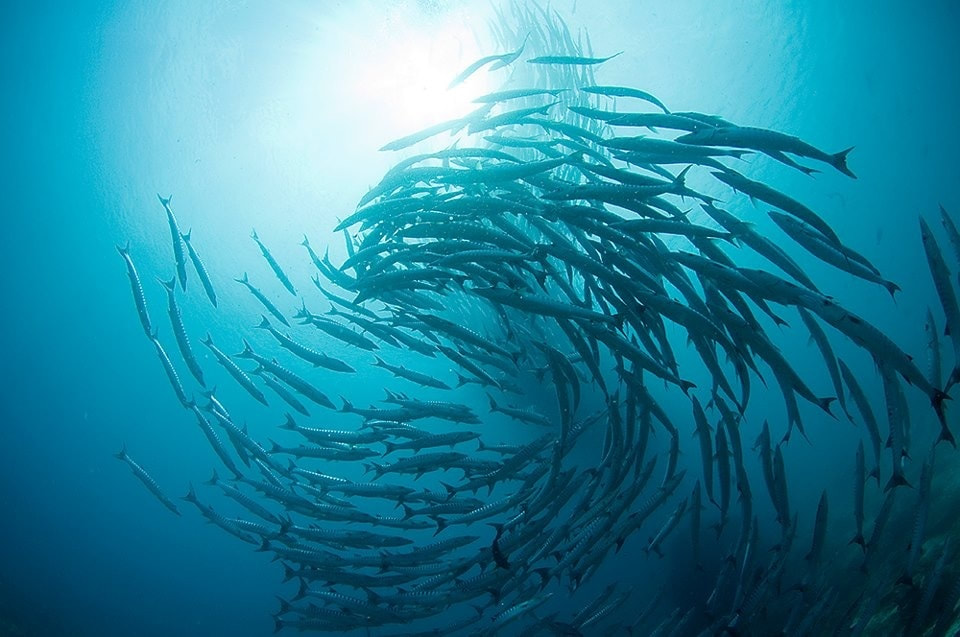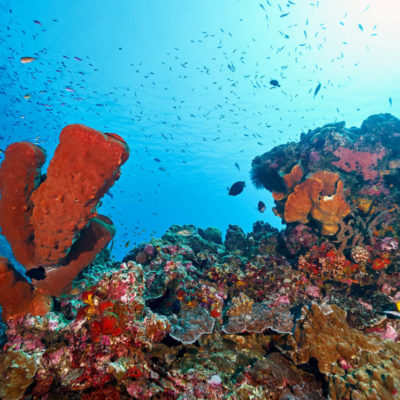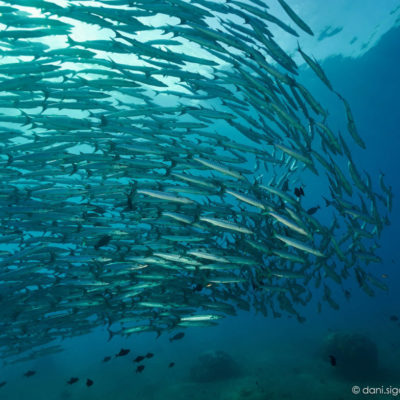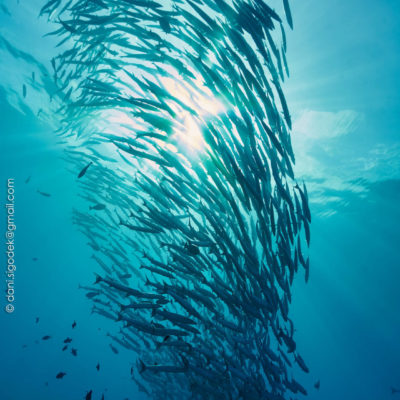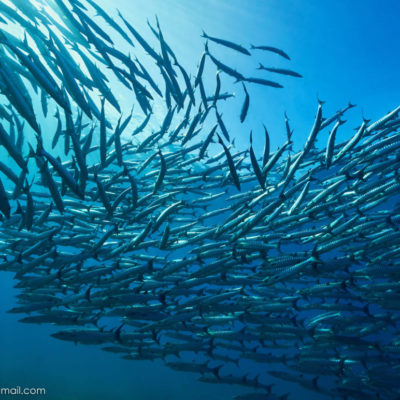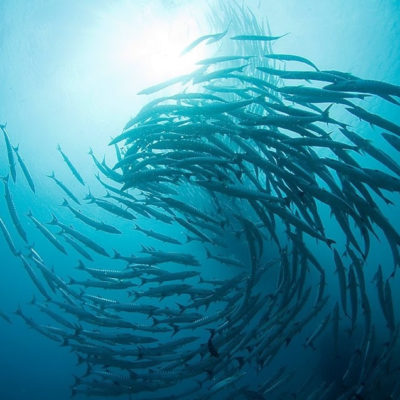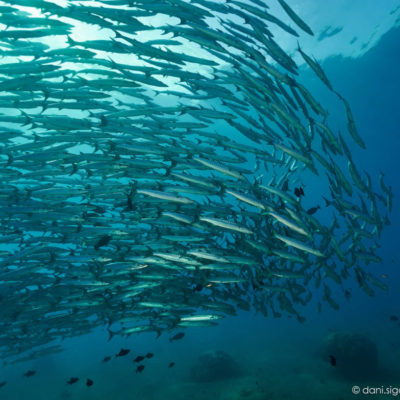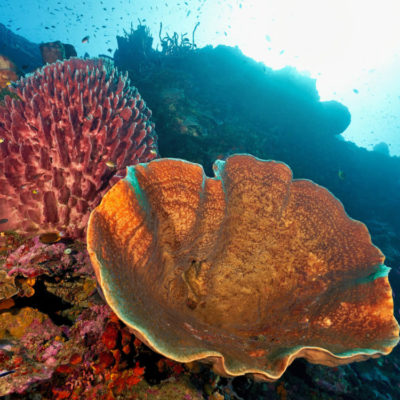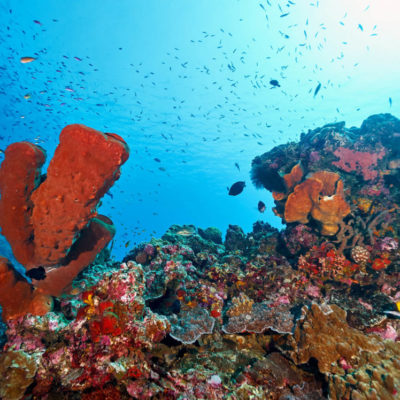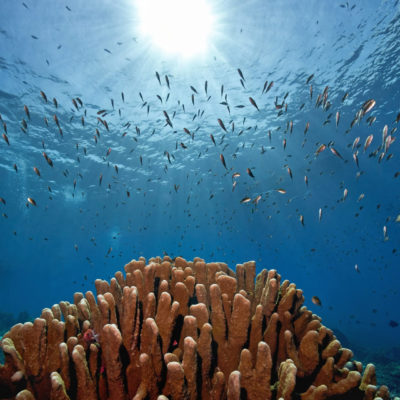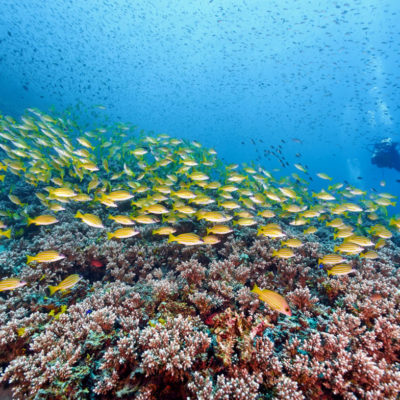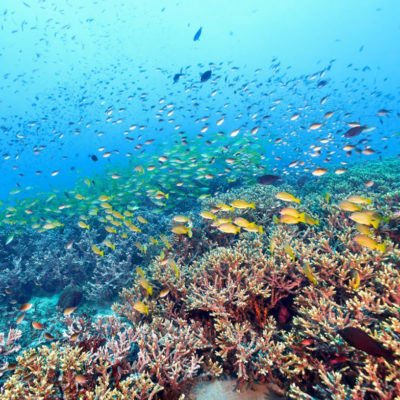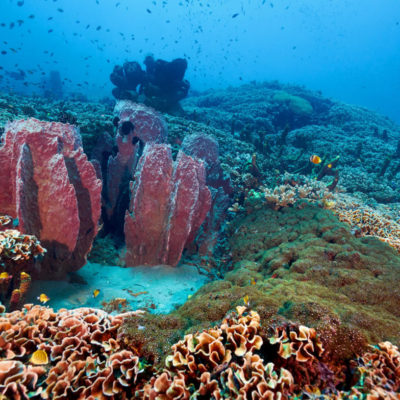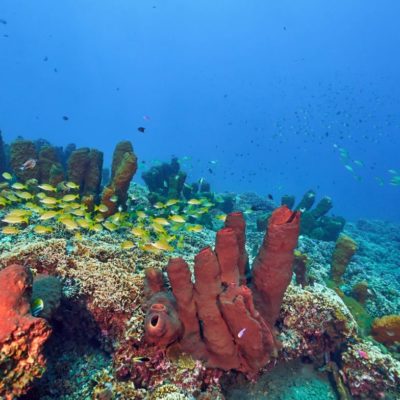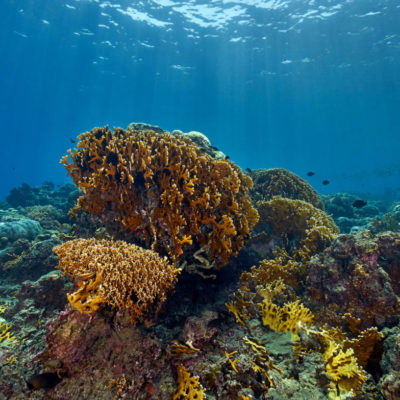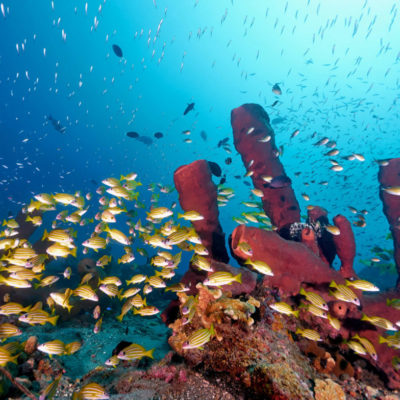Sed ut perspiciatis unde omnis iste natus error sit luptatem accusantium doloremque laudanti.

Dive Sites
Sanctum Una Una offers 4-5 dives every day, 12 months a year, 7 days a week.
We have professional diving team made up of 2 instructors, 2 local divemasters.
We like to dive in small groups, max 5 people per guide.
Most of the dive sites are 5-10 min boat ride away from the resort.
One of our best dive sites, Pinnacle 1 is just in front of Sanctum, featuring
massive dogtooth tuna, Napolians, schools of fussiliers, Jacks, eagle rays and white tips.
We also do a half day trip to Apollo reef the south of the Una una island. We make two dives on this trip, were you see two dives sites and have a nice break at the beach.
Be one of the first to diving these amazing dive spots.
Do it with Sanctum.
Frequently Visited Dive Sites
- Manta point : Top 1 dive destination in Bali and all of Indonesia, Manta point offers near certainty of finding big manta rays majestically flying through the huge bommies of coral pinnacles, little walls of corals and sloping with sand with a lot of sting rays and some reef sharks and eagle rays.
Highly sought after trip, we dedicate a trip to this place very frequently
Highly recommended for anyone visiting Nusa Penida Island
- Toyapakeh : Normally visited during high tides to make sure the current at a very friendly pace, Toyapakeh boasts a vibrant colorful reefs filled with turtles, schools of fishes, and if you are lucky mola mola/sunfish during the season which starts from July – November
Highly recommended after manta point dive sites
- SD point : Located in front of Sekolah Dasar (elementary school) in North reef, SD point is amazing for Drift Diving specialty, since it boasts a long line of drift in the coast of Penida island. Reaching good speed and fun animation of turtles and big schools of fusiliers, chubs, batfishes and watch out for sharks passing by in the blue every once in a while. Simply maintain your buoyancy and relax, no need to exert yourself the current is taking you in for a ride
Highly recommended any time of the day and any season of the month
- Crystal Bay : The most dived bay in Nusa Penida island, Crystal bay is famous for its mola mola sighting in the season of July – November every year. The chances of seeing mola mola here at the right season and right timing is so great that during the season of mola mola is a must place to visit this place
- PED : Named after the great temple PED, this is amazing dive sites for beginners and pro alike, it offers the chances to do nice easy dive skill in some shallow sandy patch area, and continue to dive along the north coast reefs that is teeming with fish life, turtles, and if you are lucky a Tresher shark
- Buyuk : Located in almost eastern edges of north coast, Buyuk offers great deep dive and has reef quality similar to those of PED and SD, with a little bit of current changes, so its highly unpredictable where the current might bring you to the west or the east
- Mangrove : Just in front of Mangrove conservation site in Nusa Lembongan, this dive site is only for advanced diver due to the drift dive can reach at 8 km/s, visibility normally super amazing and filled with healthy vibrant reef, barracudas and many reef fishes are normally here. Watch under the corals, you probably would see some nice white tip reef sharks resting after a night hunt
- Blue corner : Located on the northern Nusa Lembongan, this dive sites must be carefully planned depending on the tides and temperature, to find the best chances to see mola mola. A dive site for experienced divers only, here we can see amazing marble rays, eagle rays and many other amazing fishes. Highly for experienced divers on mola mola season
- Blue Garden : The coral gardens in the blue will never be able to be forgotten by divers since it is filled with huge bommies of coral pinnacles and table corals, you will find many batfishes schools, green turtles, hawksbill turtles, napoleon fishes, and never forget to sometimes peek in the blue while drifting to have a chance to see Whale Shark, Hammerhead shark and or Tresher shark
- Karang sari : Amazing place for diving at the eastern of the island, Karang Sari offers quiet dive site for divers since its so far and rarely visited by divers. Mola mola is a chance to see here at the season July- November, and has similar qualities that northern coast has
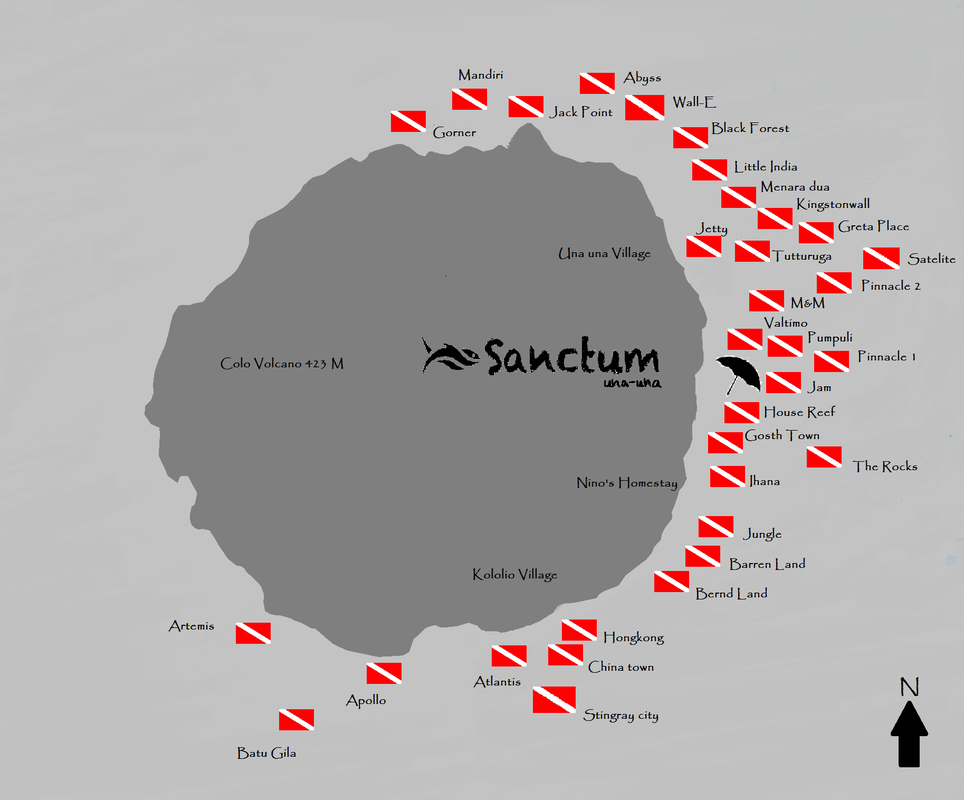
Jam
Jam, also referred to as our house reef, is an exceptional dive site which is located directly in front of Sanctum. Jam was given this name as it is literally a traffic jam down there, and the amount of fish and the variety is unbelievable.
The reef begins at 14m after a brief 5-10 minutes stint over sand in 5-15m depth. In the sand it is possible and highly likely to spot different species of Nudibranches and Flatworms, which are less likely to be found over reef, so keep your eyes open!
At your arrival at the reef, you will be amazed at how large the corals, the sponge, soft corals & hard corals, completely untouched, that goes for the other sites here as well. The majority of the dives here will be around 15-20m, making them suitable for all divers, with very mild currents experienced on and off throughout.
Here you can witness Green and Hawkbill Turtles, Napoleon Wrasses, Dogtooth Tuna, Spanish Mackerels, Herds of large Bumphead Parrotfish, and there has also been recent and frequent sightings of Black Tip Reef Sharks. You also have a very high chance at spotting Cuttlefish, Ghost Pipefishes, Shrimps and Nudibranchs. Large Eagle Rays gracefully glide through the water passing by the deep reef.
Visibility at this site depends on the tide, time of day, prevailing currents, and other factors taken into consideration. For the staff here this site is one of the favourites and should definitely be on your list of dive spots. It will set your expectations extremely high and it has every right to, as other dive sites are fascinating in their own way.
There are other dive sites all over Penida, these above are normally dived and are well known. Should you have enough group and experienced diver enough (+/-) 100 dives. We can arrange a special trip to namely Banah Rock, Trevally Ally, WC and or Malibu points.
All are very rarely dived due to the distances and difficulties but yes we can make it happen if you are 6 people or more and has at least 100 dives on the log.
Pinnacle is currently ranked, and has been consistently so, in the top 100 dive sites in the world according to various sources. The amount of fish you will see here is truly breathtaking, especially on the Northern Tip. Here and throughout the dive your vision will be blurred by the bounteous array of fish passing you by. The site ranges from wall to slope as it is a mountain towering off of the sea bed. There is a rather huge school of Jack Fish circling around the site, often forming shimmering silver walls as they light up in the sunlight, boasting awe inspiring displays nature is generous to share with us. Eagle Rays are a common sighting on the Eastern Wall, often providing the divers with close encounters, as well as many a Spanish Mackerel, Wahoo, Napoleon Wrasse, Reef Shark, Green and Hawksbill Turtle, Great Barracuda, Bumphead Parrotfish herds and Giant Grouper. All of them are easily found here residing in the Pinnacle´s healthy reef system. The corals here are so dense (just as on every site), leaving not a single inch of sea bed visible to the eye.
Hong Kong is a densely populated underwater metropolis. It bustles with fish, the sheer number of which found in this site brings justice to the name. Hong Kong consists of two separate reefs that are rather shallow, so it makes for a great dive after Apollo. The corals here are extremely healthy and the sunlight blasting through the water lights up the corals like fireworks. On the dive you can expect to see Napoleons, Turtles, Cuttlefish, Octopus, Pipefish, Nudibranchs, and many other critters and creatures. Visibility at this site varies from average to just great.
Greta’s place is an exceptionally serene site with the wall heading in a northerly direction. The wall is covered in large soft and hard corals, often being larger then the average person. Gorgonian Sea Fans exude light like in children’s book, they break off from the wall each forming their own microcosm. Cone shaped hard corals larger than you could even imagine possible litter the wall every few meters. Eagle Rays fly past on the Eastern Side of the wall, Blacktip and Whitetip Reef Sharks scout out the deeper areas of the wall. The monstrous Napoleon Wrasse inspects various areas of the wall, and some even are resident to the area. Dolphins are a possible sighting as well, so cross your fingers. Current can be of some concern at Greta’s Place, on occasion, thus an in-depth briefing will be conducted prior to the dive. Visibility is generally top notch at 20-30m.
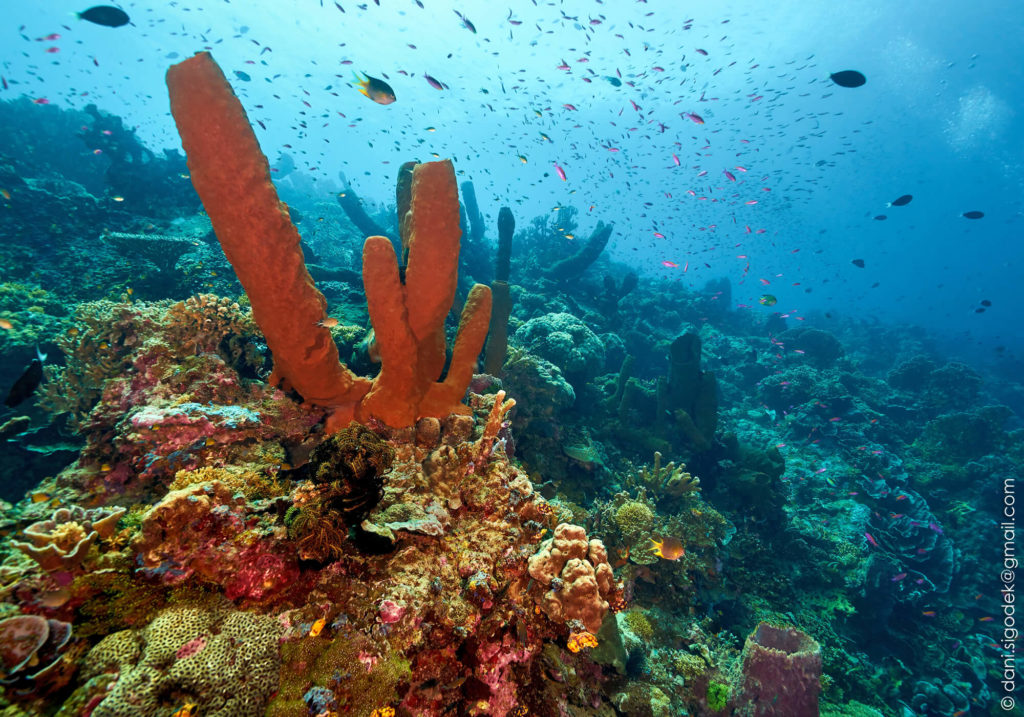
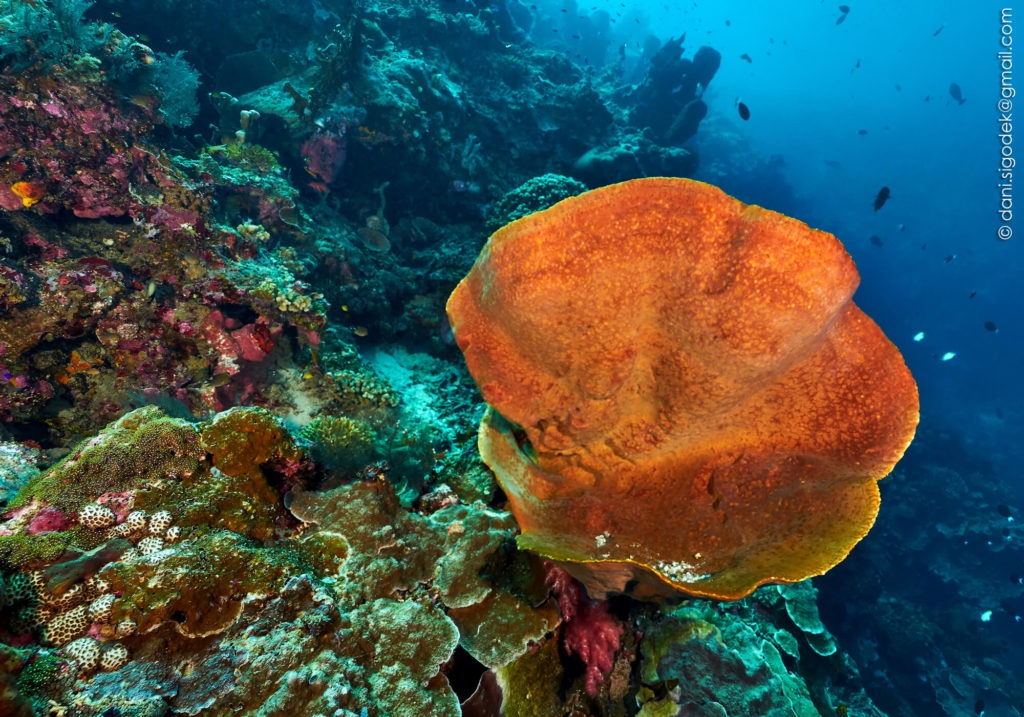
Apollo is a must see dive site here at Una Una. Here we have an exceedingly high possibility for coming face to face with an enormous school of Blackfin Barracuda, easily numbering in the thousands, massive age old Green Turtles rest silently on the sea bed, making solid eye contact with you in a rather peculiar way. Eagle Rays whizz past the deep reef, Dogtooth Tuna, Spanish Mackerels, Bumphead Parrot Fish, Reef Sharks and other Pelagics are frequenters of this pure joy of a reef. Here you will feel like you are in an aquarium, as the amount of fish will crowd your view and you will only wish you could stay longer.
The reef begins at 22m and continues down to 35m, the whole dive is generally conducted at around 25-30m so our no decompression time limits our available bottom time. That is not to worry, as we will soon head into the Lunar Landscape, a black sand desert with rolling mounds of sand, with the action of the waves creating parallel lines in the sand and with scattered fallen coconut trees creating a site suitable for spotting interesting Macro Life, such as Pipefishes, Shrimps, Crabs and possibly certain species of Seahorse. Visibility here is exceptional at 30-40m. Currents can be of some concern but it is discussed at length prior to the dive by your guide.
Note: This dive is 30min away by boat and it is only put into place if there are enough customers interested in going (min 4.). It is made as a double dive, you will complete your second dive at Hong Kong on the way back from Apollo. Surface intervals will be completed on the beach, where light refreshments will be served.
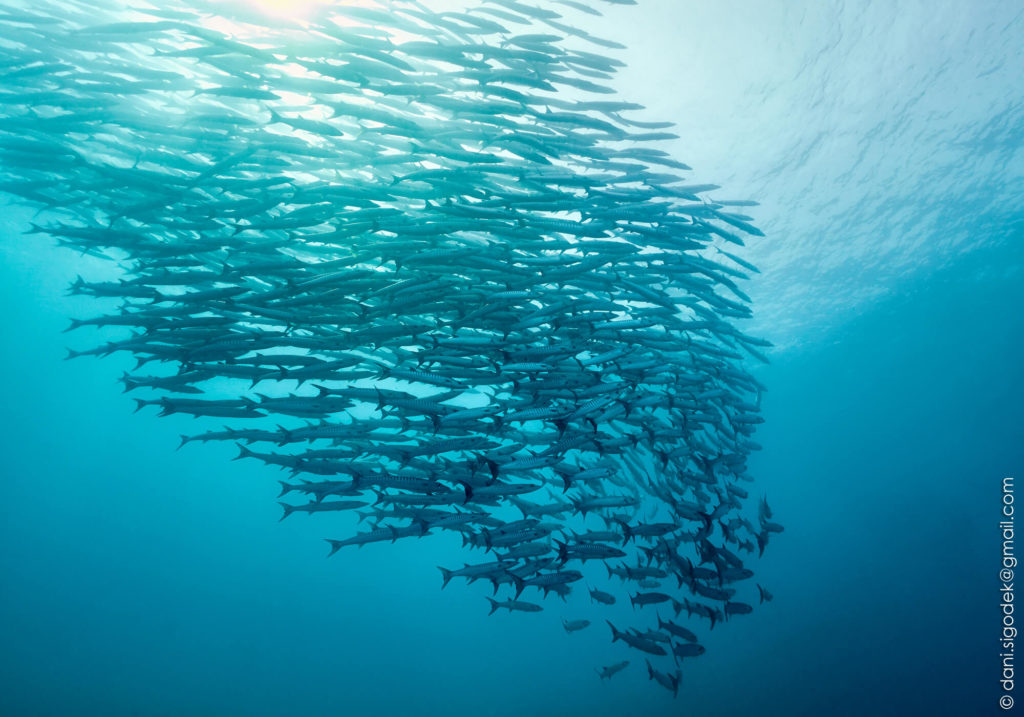
Kingston’s Wall is a dramatic wall plummeting down to 50m plus. Here, depending on your guide, we usually hover between 15-25m, with deeper dives also common upon request. Here the wall corals are covered with Gorgonian Sea Fans as large as yourself (take your chances at spotting a pygmy nestled there) and Tube Sponges towering like skyscrapers. There is truly nothing like this lying around the coasts of Central Sulawesi. Towards the end of the dive you will find yourself basking in its coral gardens, the shallow waters atop of the wall, where the sunlight beams through the water to light up the copious amounts of corals on show. Here you have a very high chance at spotting the graceful Eagle Rays, Napoleon Wrasses, and Bumphead Parrotfish. Visibility is generally top notch at 20-30m. Currents are not of concern here, as they rarely affect the dive.
FROG FISH ON UNA UNA, TOGEAN ISLANDS
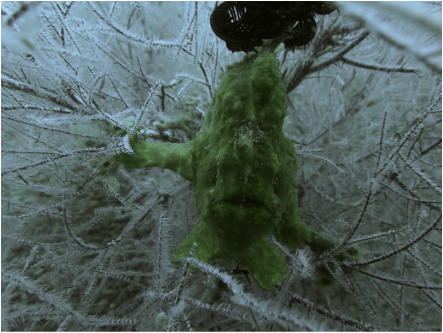
SPOTTED EAGLE RAYS ARE COMMON AT UNA UNA
Menara II is a mesmeric wall dive with caves and overhangs scattered on all parts of the wall. The coral formations along the wall are amazing and on the reef top the corals are glorious. The wall plummets to a massive depth, so keep your eyes on the blue, as this is a great site to spot Pelagics and Eagle Rays. Menara II is to the only dive site to have a cave on the island, that we know of so far.
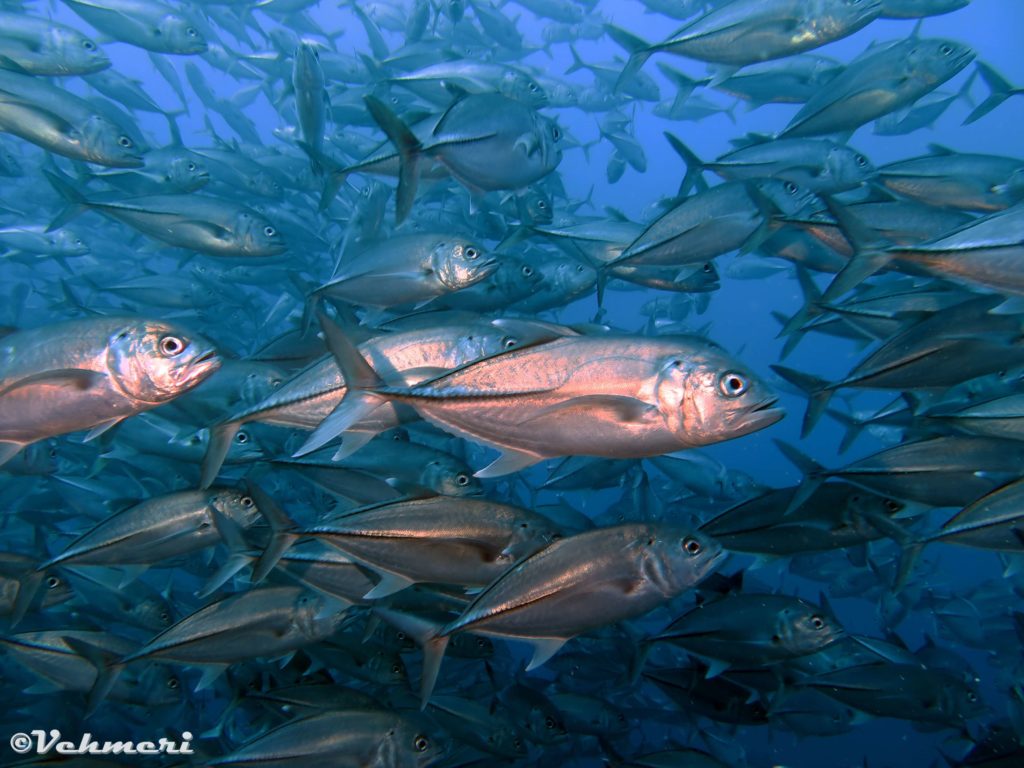
Jungle is a mysterious site and considered as a semi-muck dive, with large parts of it being over sandy bottom. The dive goes from slope to wall to flat sandy bottom, and visibility is generally low as the sea bed is quite silty. But thats not to worry. Macro life is the main objective of this dive so be ready to squint your eyes and behold the magic hidden there. Turtles and Napoleons casually swim by the reef on a regular basis.
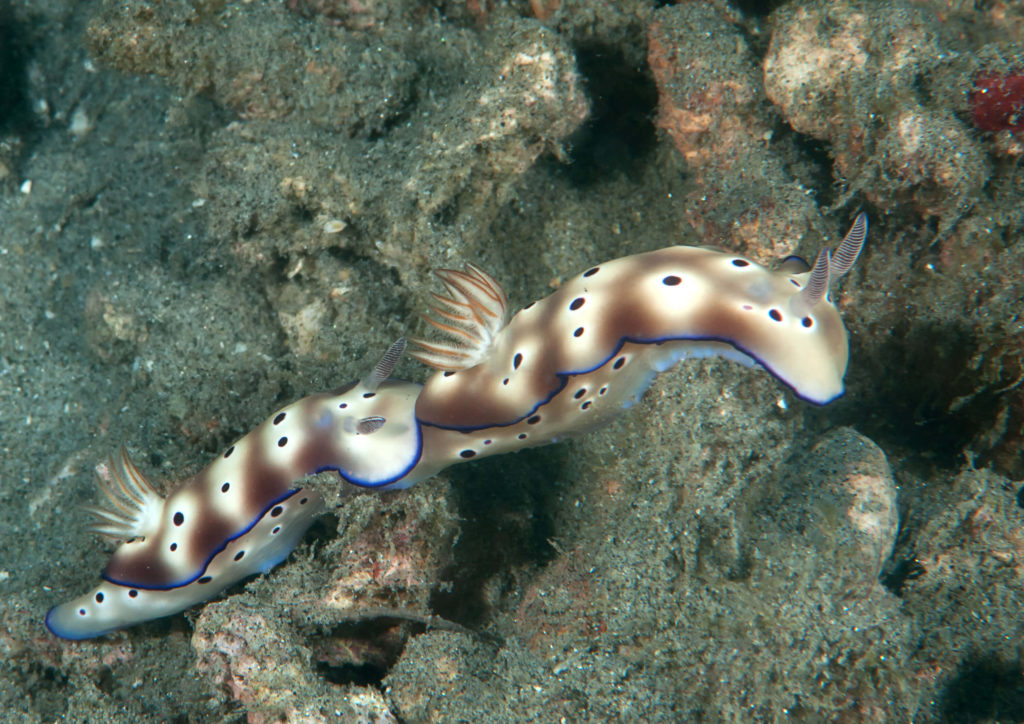
Jack Wall, as its name suggests, is another wall dive here on Una Una. The farthest dive site on the northern side of the island, its corals by some people are considered to be the best Una Una has to offer. Lush coral gardens as far as the eye can see lie on the reef crest just before the massive drop off. The site ranges from wall to slope but the majority of the dive is along wall.
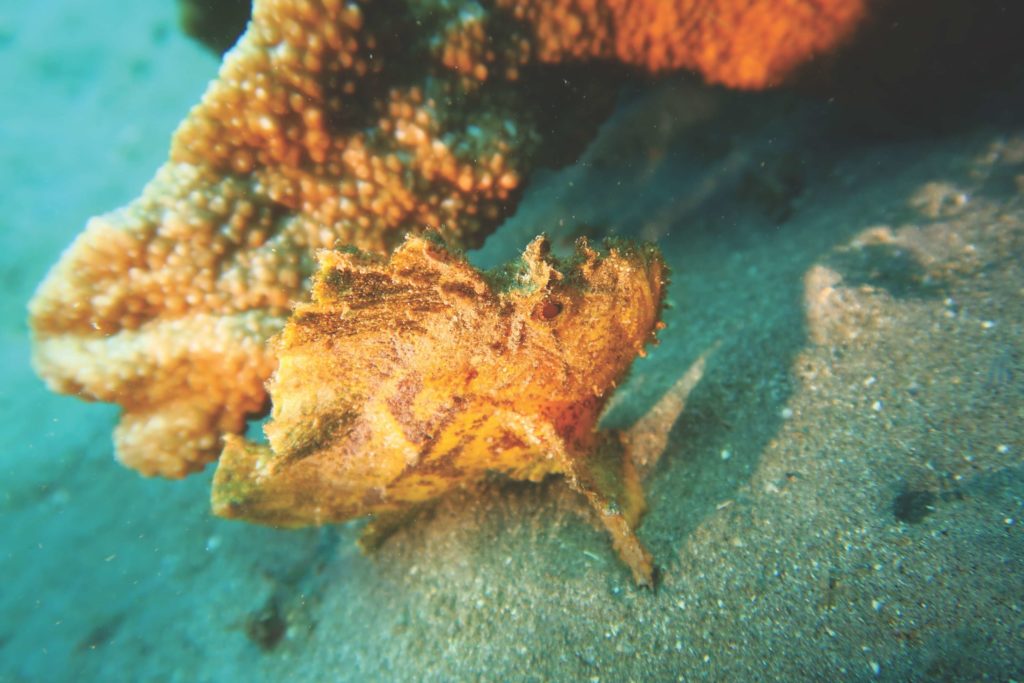
As an Indonesian diver, I could personally say that Una-Una have got to be one of the best dive sites in Indonesia.”
The Rocks – Alcatraz
This dive site was given the name Alcatraz on account of the mysterious large rock formations that sit there, silently, broodingly, on the sandy sea bed.
We saw Napoleon fish almost on every dive, schools of jack, rays, turtles, and the friendliest school of barracudas, not to mention the healthiest and abundant coral. We even get the chance to witness the bioluminescence of the planktons in our night dive, which is amazing”
“Fantastic Resort! Best in Togian!!”
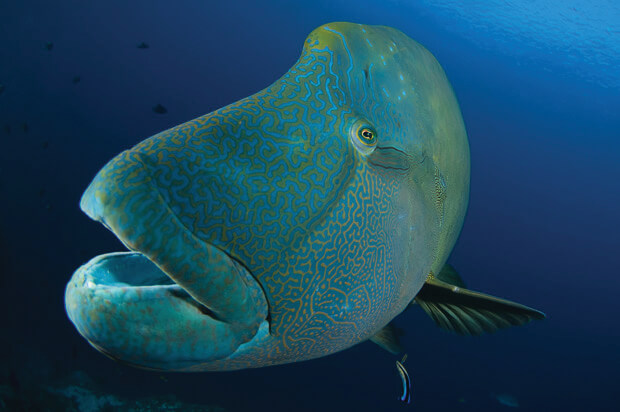
“REINO” CUTTLEFISH AT HONGKONG
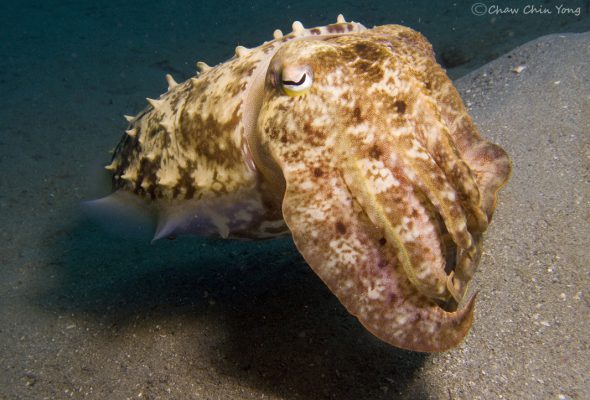
We have been to the Togean Islands three times, and Emmi and Andri’s place is without doubt the best place to stay.”
– Fanny, Denmark
